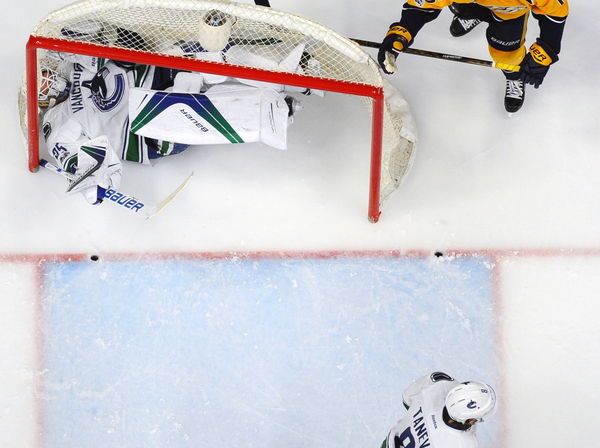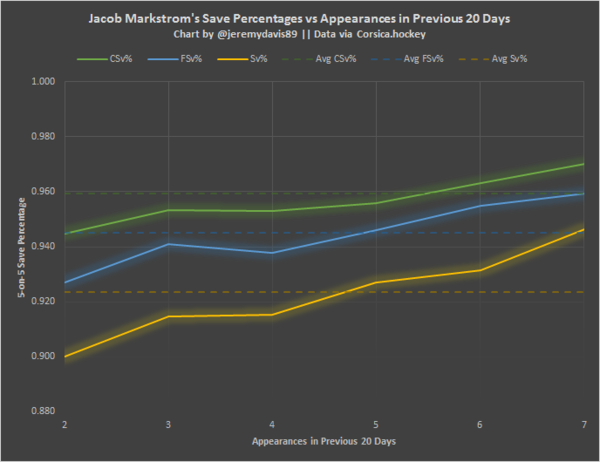Should the Canucks Commit to Jacob Markstrom?
By J.D. Burke
7 years ago
Photo Credit: Christopher Hanewinckel – USA TODAY Sports
When the Canucks face the Calgary Flames on Saturday, they’ll have played 22 games since the turn of the calendar. Jacob Markstrom’s been their netminder for five.
The obvious story therein is the number of starts Miller — a 36-year-old netminder who’s raised concerns in each of his two previous seasons in Vancouver about his workload — received in that stretch, and with good reason. It’s neither to the team nor the player’s benefit to do so, and nothing suggests they’re changing their ways in the second leg of this most important stretch of their season.
I wonder, though, if that’s equal parts faith in Miller as it is skepticism of Markstrom’s ability to so much as hold the fort. That’s idle speculation on my part, but for posterity’s sake, I wanted to see whether the Canucks are justified in their reticence to commit to Markstrom in any meaningful way.
At a surface-level glance, I tend to think that any goaltender worth starting a significant amount of games as either a tandem starter or sole keeper of the crease will have proven as much by the time they’re Markstrom’s age. We often talk about Markstrom as a part of the next wave, or the future of the Canucks’ crease until Thatcher Demko’s ready, but he’s 27-years-old.
Markstrom’s current pace will see him start roughly 36 games for the Canucks, which represents a career high, but could also be inflated by early usage and oversold relative to how often he’s played since the turn of the calendar. Considering the lead horse in the Canucks crease is 36-years-old, that’s a light workload.
Contrary to popular belief, it’s not like Markstrom has done much to this point in the season to suggest that, in a vacuum, he’s earned more starts — of course, he should get more regardless, since the alternative is a 36-year-old Miller. This extends well past Thursday night’s aerating courtesy the St. Louis Blues, too.

Average goaltending in the NHL looks like about a .912 Sv%. Markstrom’s rocking a .910. If we peel back a couple of layers and look closest at even-strength save percentage, Markstrom’s .927 is 33rd among goalies who’ve played 100 minutes or more at even strength. Expand that sample to include last season and Markstrom’s .920 Sv% at even strength is 50th among qualifying goaltenders, right beside Kari Lehtonen; if you account for Markstrom’s entire career, he’s 96th among 112 qualifying netminders with a .911.
Besides these quantifiable harbingers, Markstrom’s biggest critique throughout has been his penchant for letting pucks through him. When speaking to goalie experts, they all seemed to indicate that, historically, Markstrom’s reached to make his saves, which can open massive holes for better-tuned shooters savvy enough to outwait the lanky Swede.
Rightly or wrongly, coaches don’t often give much leeway when goalies are letting weak goals get past them. The overall body of work has to be so overwhelmingly positive for them to overlook that kind of thing. Risk averse as Canucks head coach Willie Desjardins is, this seems doubly true of Markstrom’s situation.
It’s fair to wonder, though, whether this is a chicken/egg argument. Is it possible, or likely even, that Markstrom’s struggled because the scant starts afforded him don’t let him find a groove? I’ve looked into the idea of whether Markstrom responds to a better workload before using shots per game as a proxy, and the evidence showed overwhelmingly that he played best with his team’s back against the wall.
“There’s a pretty reasonable case to be made that Markstrom benefits from an increased workload. It would certainly explain why he’s struggled to establish himself as an NHL backup and only ever showed as quasi-competent in a brief stretch as a starter.If anything, it adds to the many reasons for pause with regards to how he’ll perform in his prescribed role this season. I would like to think that he’s up to the task, but it seems fair to wonder how well he’ll perform if they put him on the Eddie Lack diet for starts; one which allows about one every third week of action behind a healthy Miller.”
Of course, I admitted at the time there were holes in the method that led me to this conclusion. Besides, shot volume isn’t something the Canucks can necessarily control on a night-to-night basis. Having read the Jeremy Davis article from a week prior wherein he uses days between starts as a measure of workload, I’ve come around to that methodology as more telling.

Markstrom’s Sv% relative to how many games he’s started in the 20 games before it suggests he plays better with an increased workload through a more rigorous run of starts — data which aligns closely with my observations about how he performs based on shot volume on a per game basis.
I would caution against reading too far into this, though. When one looks at Markstrom’s showing based on different workloads, the conclusion shouldn’t be that he’s an elite goaltender when he plays more often in more difficult scenarios. Naturally, as a backup goaltender, the sample of games played in the four-plus start per twenty days range is going to be small. Enough so that it’s likely inconclusive and doesn’t hold a tonne of predictive value.
We can’t say with any confidence that Markstrom is a late bloomer with signs pointing to Thomas Greiss like potential to develop into a high-end starter from seemingly out of nowhere. In fact, the sample probably skews more heavily towards the Anders Lindback end of that spectrum.
Regardless, given the Canucks current crease scenario, they should be willing to experiment and find out. The fact that Markstrom has a non-zero chance of developing into a long-term starter suggests it’s worth exploring. It’s not like the current setup is working for the Canucks. They are very much a team that can afford to experiment.
The Canucks signed Markstrom to a three-year contract extension last July, and they didn’t exactly penny pinch when they did so. There’s obviously some level of commitment to Markstrom, even if that only extends so far as a well-compensated backup.
Wherein the problem lies is that they’re less a year removed from putting pen to paper and every indication since suggests they don’t even have interest in finding out if there’s more there. Whereas I can see where the skepticism is borne, and even carry a certain amount myself, there’s almost certainly a short-term benefit to playing him more and they might find a starter along the way too.
Recent articles from J.D. Burke





